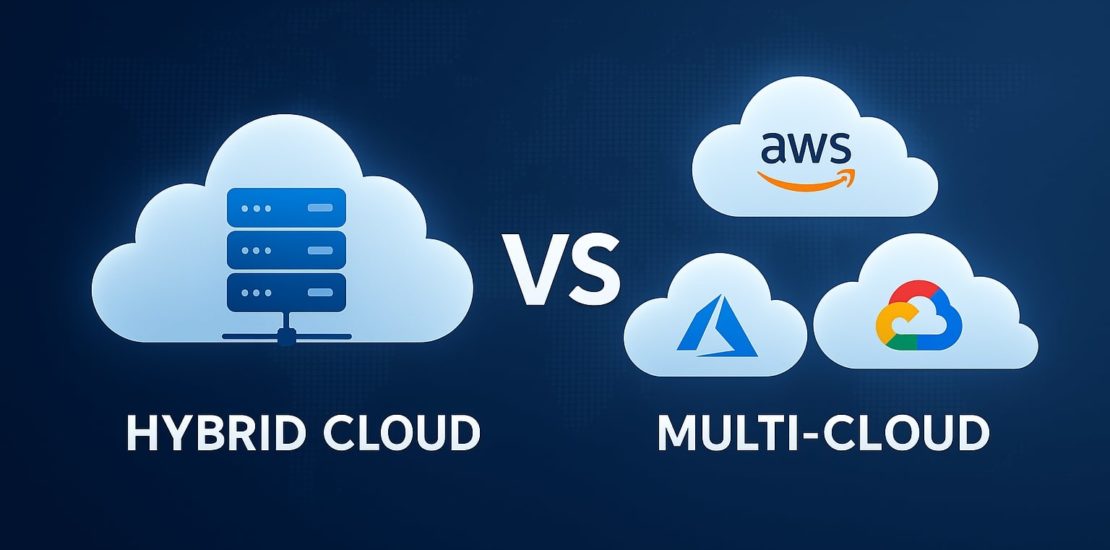Hybrid Cloud vs. Multi-Cloud: Which Strategy Works Best for Enterprises?
- September 25, 2025
- Posted by: Gradeon
- Categories: IT Infrastructure, Cyber Security

Cloud computing has become the backbone of modern IT strategies, giving enterprises the ability to scale, innovate, and compete in a fast-moving digital economy. But as organisations expand their use of cloud technologies, the conversation often shifts to a critical decision: should they embrace a hybrid cloud or a multi-cloud strategy?
Though the two terms are sometimes used interchangeably, they represent different approaches with unique benefits and challenges. Choosing the right one depends on a business’s objectives, industry requirements, and appetite for complexity.
What Is Hybrid Cloud?
A hybrid cloud is an IT environment that combines public cloud services with private cloud or on-premises infrastructure. The goal is to create a unified ecosystem where workloads can move seamlessly between environments. This setup allows enterprises to enjoy the scalability of public clouds while maintaining control over sensitive workloads within private systems.
For instance, a healthcare provider might keep patient data in a private cloud to comply with strict regulations but run advanced analytics on a public cloud to take advantage of on-demand scalability.
What Is Multi-Cloud?
A multi-cloud strategy, on the other hand, focuses on using two or more public cloud providers at the same time. Instead of blending private and public resources, enterprises leverage the unique strengths of each provider. One vendor might offer superior AI tools, while another provides more reliable storage solutions or competitive pricing.
Take the example of an e-commerce company that hosts its website on AWS for stability, relies on Google Cloud for personalised product recommendations, and uses Microsoft Azure for integrating enterprise applications. This approach helps businesses avoid dependency on a single vendor while ensuring they get the best of what each platform has to offer.
Key Differences Between Hybrid Cloud and Multi-Cloud
| Aspect | Hybrid Cloud | Multi-Cloud |
| Definition | Mix of private/on-premises and public cloud resources. | Use of multiple public cloud providers. |
| Primary Goal | Balance between security/control and scalability. | Optimisation, flexibility, and avoiding vendor dependency. |
| Integration | Strong integration between environments. | Loosely connected or independent environments. |
| Use Cases | Compliance-heavy industries, sensitive data workloads. | Global businesses seeking flexibility, redundancy, or specialised services. |
| Complexity | Complex in integration and management. | Complex in vendor management and workload distribution. |
Advantages of Hybrid Cloud
The biggest advantage of hybrid cloud is control without sacrificing scalability. Enterprises can store sensitive data or mission-critical systems in a private environment while shifting other workloads to the public cloud when demand spikes. This ensures cost efficiency while meeting security and compliance standards.
Hybrid cloud also works well for organisations that still rely heavily on legacy infrastructure. Instead of a full migration, they can modernise gradually by connecting their existing systems to public cloud resources. For industries like healthcare, finance, or government, where compliance regulations are strict, hybrid cloud offers a safe balance between innovation and governance.
Advantages of Multi-Cloud
Multi-cloud shines in its flexibility and resilience. By spreading workloads across different vendors, enterprises are not tied to one provider’s limitations or pricing models. This also reduces the risk of downtime; if one provider experiences an outage, workloads can often be shifted to another.
It also enables organisations to pick and choose specialised services. A company may rely on Google Cloud’s machine learning capabilities while taking advantage of AWS’s extensive storage and Azure’s enterprise integrations. For global businesses, multi-cloud improves reach by accessing data centres across various providers, ensuring better performance in different regions.
Challenges of Hybrid Cloud
Despite its strengths, hybrid cloud is not without obstacles. Integration between private and public environments can be complex, often requiring advanced expertise and ongoing management. Security misconfigurations are also a concern, as gaps between environments may expose vulnerabilities.
Cost control can be another challenge. While hybrid cloud promises savings, running both private infrastructure and public resources simultaneously can lead to overlapping expenses if not carefully monitored.
Challenges of Multi-Cloud
Multi-cloud comes with its own complexities. Managing multiple vendors means dealing with different billing models, security frameworks, and service-level agreements. IT teams need expertise in several platforms, which can stretch resources thin.
Transferring data between providers is also expensive and sometimes slow, raising concerns for businesses with large volumes of information. Compliance can become harder to manage too, especially when providers operate under different legal jurisdictions.
Which Strategy Works Best for Enterprises?
The choice between hybrid cloud and multi-cloud largely depends on an organisation’s business model and goals.
Hybrid cloud is often best suited to enterprises operating in heavily regulated sectors. These businesses need full control over sensitive data but also want to benefit from cloud scalability for less critical workloads. It’s also the right fit for organisations with significant investments in legacy infrastructure that cannot be retired immediately.
Multi-cloud, in contrast, works well for companies looking for vendor independence and global reach. It appeals to businesses that want access to best-of-breed services and the ability to negotiate better pricing or performance by not relying on a single provider. Enterprises with distributed teams or customer bases across multiple regions often find multi-cloud particularly advantageous.
Some organisations even combine both approaches into a hybrid multi-cloud strategy. This blends private systems with multiple public clouds, offering maximum flexibility, though it adds another layer of complexity to manage.
Final Thoughts
When it comes to hybrid cloud vs. multi-cloud, there is no one-size-fits-all solution. Each approach serves different needs.
If compliance, data protection, and legacy system integration are your priorities, hybrid cloud is likely the smarter choice. But if your focus is on flexibility, innovation, and reducing dependency on a single vendor, multi-cloud offers greater advantages.
Many forward-looking enterprises are even blending the two, ensuring they remain secure while also agile in a competitive digital landscape. Ultimately, the best strategy is the one that aligns with your enterprise’s vision for growth, resilience, and innovation.
